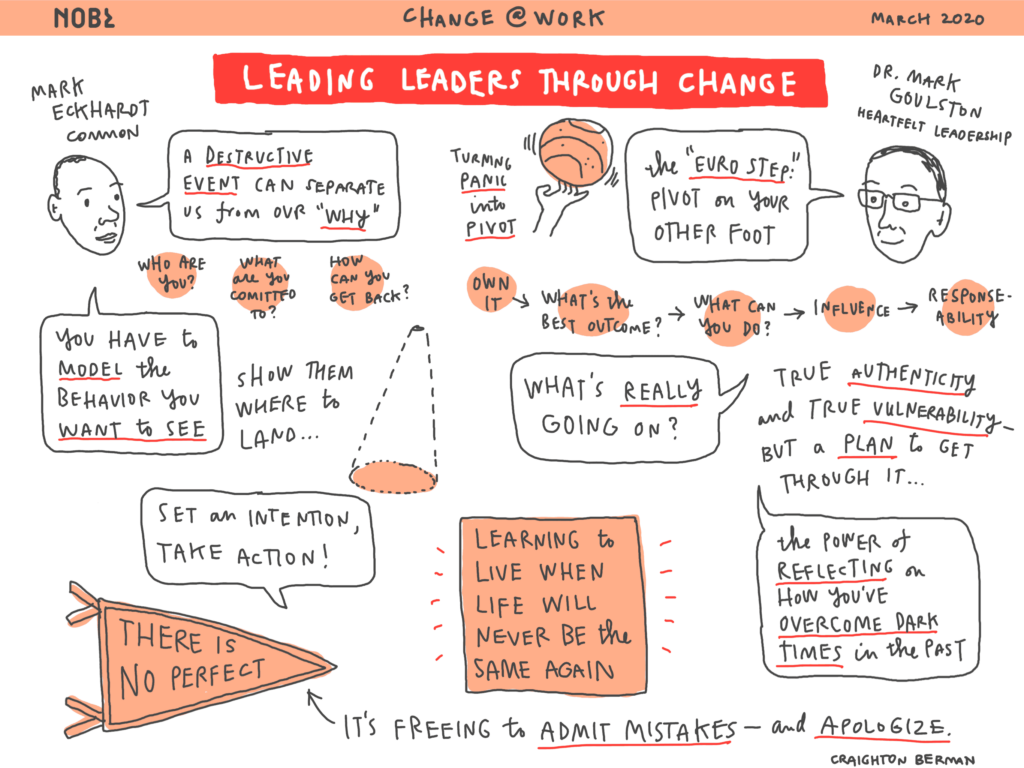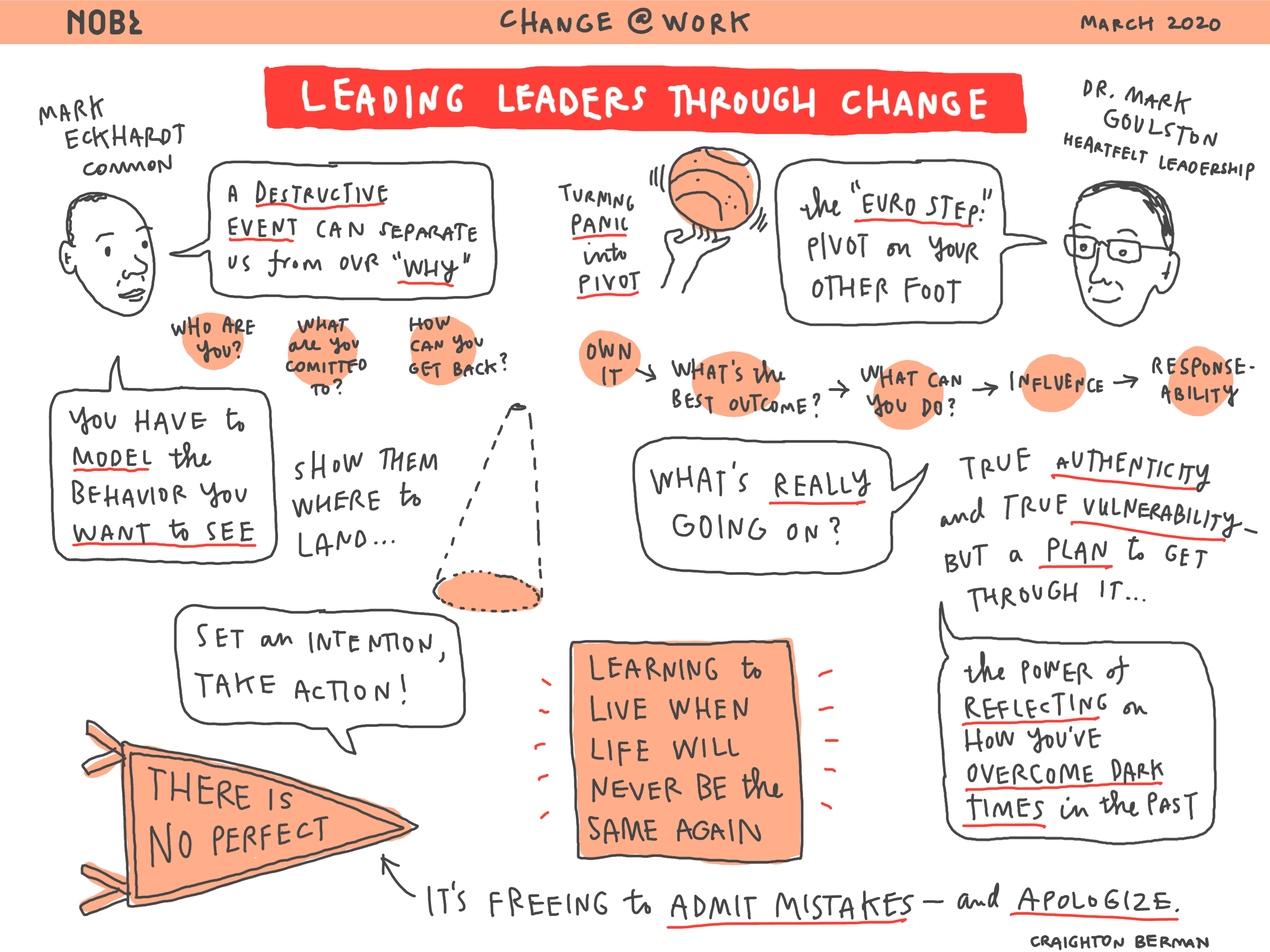In their respective roles, Dr. Mark Goulston, Co-Founder of Heartfelt Leadership, and Mark Eckhardt, CEO of COMMON often find themselves coaching leaders through crucial changes. No matter what your level in your organization, try the following when dealing with dramatic change:
- Connect to your “why.” To move forward, you have to understand what motivates you. Who are you? What are you committed to? What have you been committed to?
- Ask “really?” five times. To get to the bottom of an issue and determine what’s really affecting people, don’t stop at their first response—keep asking.
- Create space for others. Give people the time—and emotional space—to work through their concerns. One useful approach is to ask them to share a story of another time when they were facing a challenging, and how they got through it.
- There is no perfect. It’s okay to admit you’re wrong—in fact, in some ways, it’s more freeing than being right. Apologize to the person you were wrong to, and share what you’ll do next so that the problem doesn’t reoccur.

Read the Transcript
Mark Goulston:
Sarah.
Sarah Dickinson:
Hi!
Mark Goulston:
Hi, Sarah.
Sarah Dickinson:
How are we doing? I’m going to call you just the Marks or Marks. Marky Marks was bandied around earlier.
Mark Goulston:
We’re M&Ms, like candy.
Sarah Dickinson:
M&M!
Mark Goulston:
Candy for these tough times.
Sarah Dickinson:
Candy for these tough times. That should have been the name of the talk.
Mark Eckhardt:
That’s right. All of it will work. Whatever-
Sarah Dickinson:
Update the website, everybody. Okay. Amazing. So how exciting. I’ll do a short introduction, then I’m going to press the pass the ball very much to the two of you for a conversation that I’ll nudge along as needed. Mark Goulston, co-founder of Heartfelt Leadership, UCLA professor of psychiatry for over 25 years, a former FBI and police hostage negotiation trainer. I’ll just leave that out there. I really hope there’s going to be some stories on that.
Mark Eckhardt:
The class was good. The class works.
Sarah Dickinson:
Right. Now, and throughout your career, an advisor, an influencer, a sought out resource for others, for entrepreneurs, e-leaders around the world, educators, one of which is Mr. Mark Eckhardt who also has a career advising and counseling others, a career, well, it began in music, right, Mark?
Mark Eckhardt:
It did. I was a professional drummer.
Sarah Dickinson:
Yes. Composer and performer headed into the agency space, I think. Digital strategy, founder of common, and again many, many years of experience leading leaders, which is the theme of our conversation today and leading leaders through change, especially. You know each other. I’ll go so far to say that your besties, especially in times of need. But I wanted to talk to you today; talk to each other and talk to you today about drawing on that wisdom and those experiences as executive coaches and advisors. Leaders are turning to you in times of duress. What are your biggest concerns right now, and how are you coaching leaders? Let’s start that market. Mark Eckhardt. Oh, Mark. Yeah, you guys go first.
Mark Eckhardt:
Go for it, Mark.
Mark Goulston:
Well, I think the challenge now is not leading through change. It’s leading through fear. When you’re leading through fear, you have to realize that whoever’s afraid, which is everybody, is their minds constrict. So when I coach executives, what they want is strategies and Lego-like tactics where one step fits to the next, to the next, to the next. Because as soon as it’s abstract, they fall through the cracks. So can I share a practice I’ve been doing with them that seems to be helpful?
Sarah Dickinson:
We’d love something like that.
Mark Goulston:
So if you go to markgoulston.com I have a blog up there. There’s something that I’m doing that Sarah, you may not know, but I’ll bet Mark Eckhardt knows. There’s something called the Euro Step, and the Euro Step comes from the NBA, and it was made popular by a player named Manu Ginobili. Really what it is, is when you’re going in for a layup and people are coming at you, think of that as the coronavirus. You pivot to the other foot. So they’re coming at you and the Euro Step is you pivot to the other foot. You only cut down your momentum slightly. So this is what I’m coaching people, I’m actually calling it, if you go to my LinkedIn profile, Euro Step, executive coaching.
Then when I apply, which is the Lego-like tactics, there’s a wonderful book that I think everybody needs to get called work arounds that work by Russell Bishop. What I loved about it, it’s how to handle anything coming at you. I’ll just tell you the five steps because they’re Lego-like. So the first step is own it. It happened. This is not a bad dream. It’s amazing. I’ve tried to go as an escapist, watched some escapist movies that are horror films and then as soon as the movie’s over, I say, “I’m living it! We’re living it!” The film is continuing. So the first step is you have to own it.
The second step is given that this has happened, what is the best near term outcome you can get? So you have to change. Given that this has happened, what’s the best near term outcome? So that’s the second step. The third step is what he calls control. What is something that you can do that you don’t need anyone else’s permission to do? You can wash your hands, you can social distance, and you can self isolate. You don’t need anyone’s permission to do that. The next step is what he calls influence. Who do you need to reach out to get that outcome, that best outcome now that the life has changed? What’s your influence ability, your ability to influence other people’s to do those things. Then as final step is what he calls response-ability, which means given these steps, what are you going to do now? But I liked that they just fit together like Lego blocks.
I mean, real quickly, own it. What’s the best near term outcome given what you just owned? What do you have control over that you don’t need other people’s permission? Who can you influence and how are you going to influence them to help you, because they’re dealing with their own thing. What is your response ability, your ability to respond? I think if you follow those, you can then pivot. Because I think that’s what we all need to do is we need to turn panic into pivoting.
Sarah Dickinson:
Yeah, yeah.
Mark Goulston:
But those are just some thoughts.
Sarah Dickinson:
No, an incredible start. I really see synergies with what Laura was talking about from the Boulder Center for Resilience in terms of the necessary step to pause and ground, with your Euro Step before we keep on moving. Mark Eckhardt, build on the Lego for us. Some more bricks. I’m just going to keep going with that analogy. Some more bricks that you are sharing right now in terms of your wise counsel to leaders.
Mark Eckhardt:
Sure, sure. Well I love the Lego approach and the Euro Step. That’s awesome, Mark. You’re getting like a ton of high fives down in the chat. I’m actually going to take those Lego pieces apart because leaders that I work with and leaders who tend to seek me out in times like this really show up with very large existential questions. Now, I don’t want to go too abstract, but these type of moments really, really start to raise questions about, who am I? Am I qualified? I’ve found in my experience that we have to do some work in that space. Kind of stand that up again, stand folks back up again, and then move into planning. It’s really interesting to see how such a disruptive event such as the one that we’re in, can really, really kind of separate us from our why, the context from which we live our lives, we generate what it is that we are doing and we approach our work.
So first and foremost, getting people connected to that why is essential and critically important. That actually pulls back the context that people are used to operating with, and there’s enough familiarity there to be able to make the maneuvers that are necessary to go forward. So it’s, what’s the why? Who are you? What are you committed to? What have you been committed to? Then what are those plans? So this is where again, where those Lego pieces come back together. Very succinct, very clear, very precise steps that people can take to move to the left, to move to the rights, and position themselves at a slightly different angle than the one at which they had been approaching from in the first place.
Sarah Dickinson:
I love that, Mark. I’m going to build on the, coming back to your own why. One of the themes that has come up today many times has been the need for authenticity. To take a cue from Brene Brown, to rumble your own vulnerability, and to really show your own humanity. I’m curious. You work with very, very high level senior executive CEOs, founders of organizations of large, large companies. A huge amount of responsibility resting on their shoulders. I want to take it up to that level to the folks that you’re working with there. What does authentic leadership at the C-suite look like in a crisis? How do they act in front of their team when you know they’re all so stressed and concerned?
Mark Eckhardt:
Mark?
Mark Goulston:
One of my good friends is General Marty Steel. We worked together on a transition program to help returning Marines from 2006 to 2008. He was the COO of the Marines in the 90s, and when we work with Marines, we ask them, “What was the most helpful thing about the transition program?” They said, “The hour and a half, one-on-one time with General Marty Steel.” I said, “Marty, what’d you speak to them about?” He said, “I use something called the five really’s.” I’m sharing this because this is what I will do with people I coach.
So you ease into it. “Well, what’s going on? What are your concerns and whatever?” What he would say is, he’d say is, “What’s really going on?” No matter what they say, he’d say, “Yeah, I understand that, but what’s really going on?” Or he might say, “I understand that, but what are you really worried about?” He said, “When you go five levels down, they look at you like a deer in the headlights, and they revealed their truth.”
So when he did that with Marines, and I’ll just try and recreate it. He’d say, “Marine, what are you really worried about? What’s really going on?” They’d look at him like this, and they’d say, “I did and saw awful things, sir. When I close my eyes, I see them more vividly. So I don’t close my eyes much, sir.” Then he would give them a direct order to put that aside. He said, “If you’ve been a Marine in active duty, we’ve all done and seen awful things. Here’s a direct order, put it aside.”
So what am I getting at? That’s something I will do with the people I coach. Because at that moment where they open up at that deep level, they are authentic. They are vulnerable. But you’re there to help. When they experience that, where they crack open, they get a taste of the power of true authenticity and true vulnerability. Because I think to me, what authenticity is showing true vulnerability, but not leaving people hanging out there. It has to be tied to courage, wisdom, a solution. They feel like, “Wow, he or she’s being real.” But if you’re a leader, you have to talk about how you got through it.
Sarah Dickinson:
Yeah. Five really’s. I love the five really’s. Mark Eckhardt.
Mark Eckhardt:
Again, this is what I love about the talking and hanging out with Mark and doing this kind of stuff with him is he sets up just great frameworks that allows me to just leap into space. I think just to keep it real simple, you have to model the behavior that you’re wanting to invite your team, the people around you, to step into. The framework that Mark has shared is really brilliant for that. In my own work with my own team, I’m the first person to just admit that I’m a hot mess. Yeah, I might be doing a great job right now. I might have some sense of clarity in terms of the trajectory that we want to pursue, but just starting with, you know what, folks? I’m good, the family’s healthy, the kids are up there smiling and having a good time, and I’m a hot mess. Let me talk to you about some of the things that I’m doing.
So we work with that to be with that, but also to kind of move myself through that. So by literally walking through the framework similar to the one that Mark just shared with us, creating the space, creating the conditions for other people to step forward and be vulnerable, knowing that there’s a place where they’ll actually land is spot on, and I can’t encourage people enough to do it. Especially right now.
Sarah Dickinson:
Yeah.
Mark Goulston:
Sarah, something I think I’ve said this to both of you. Something I did after 9/11 I actually have a blog called, I think, Post 9/11 Do Over or something like that. Deja Vu. I was called in to organizations and companies to meet with high net worth clients and workers, and they said, “Calm them down.” What I did is I had people share, and maybe we could each do this. We could pull this off even here. I said, “Share a dark time in your life that you never thought you’d get through, but you got through, and what it proved to you is you’re much stronger and more resilient than you thought you were.” People went around the room, and I did this for a big financial service companies with their high network individuals, and there was about seven people at a table, and they just opened up.
A couple of years later the branch manager said to me, “I got to tell you just from that one meeting, those clients have been the easiest to manage compared to all my other clients when we have to deal with bad news.” So I think if you allow people to share that, what’s going to happen in your organization, and I’m in neuroscience, is everyone’s going to get a burst of oxytocin and bonding. Oxytocin lowers cortisol. When people feel connected and feel felt, it lowers cortisol, it lowers reactivity. So if you ask them, “Talk about a dark time,” it also helps, “Talk about a time where someone helped you through it,” because then what you tap into is gratitude towards that person who helped you through it. It’s fascinating, the power of that.
Whenever I’ve done this, I’ve done this probably in 30 occasions in various settings. Did it to 200 CEO’s in South Bend a few years ago, and when they all share, what I say, “How many of you feel that you’re in a room with special people?” Everybody puts their hands up, and they’re not any more special than when they walked in. But when they shared their vulnerability, their courage, their gratitude, it just flexed the whole room.
Sarah Dickinson:
Yeah. Yep. I mean, I love hearing about that method and just drawing us to neuroscience and back into what our bodies already know. There is wisdom in there to be tapped. I want to round out our discussion again. Maybe starting again with the neuroscience piece around, as leaders, how can we bring people together? That’s what I was also drawing from that connected experience there that you just spoke to. Hearing the powerful stories as both a personal reminder that we’ve been here before, that we will come out the other side. We’re stronger than we think. But I’m sure you’ve both got something to share in terms of how as leaders we can bring people together right now.
Mark Eckhardt:
Well, I have to be authentic. If you really intend to bring people together, then that has to be real. It can’t be fake. It can’t be something that you feel like you’re obligated to do because you’re in a time of uncertainty. So if that’s very real for you, then be authentic and take action, take initiative, reach out to people. Make phone calls, send emails, invite them to participate in something that you may have scheduled, like an event like this which is amazing, which has brought people in from around the world.
But also be clear about your intentions and whatever path that it is that you’re seeing that you want to pursue together with them. Then invite them to contribute to articulating that, clarifying that, and then committing to that, and linking arms. At this point, because I know time is limited, I’ll pass over to Mark.
Mark Goulston:
Something I think I shared with you guys, one of the most eloquent quotes, and I collect eloquent quotes, came from a person who was very close to her larger than life dad. She came in, and she didn’t think she could go on. She was so close to him, and she came in and she said, “I’m better.” I said, “What happened?” She said, “You know what it comes down to is living with life never being the same again.”
That doesn’t mean it will be different. I wish my dad was around. But it doesn’t mean I can’t laugh. It doesn’t mean I can’t love, it’ll just never be the same again. So something you can do with your people also is have them share moments in their life where they learned to live with life never being the same again. Could be a cancer, a bankruptcy, because that’s what this is. That’s what 9/11 was. Well, we learned to live with life never being the same again. The point is, we’ve already done it many times, but you want to draw that out of people because again, when you draw that out of people, people bond, big oxytocin, people are inspired. That’s a hit of dopamine, and you send the cortisol running.
Sarah Dickinson:
Yeah. Yeah. Shoo, shoo. I’m going to ask one question from the floor, and looking for a speedy answer. But I think it’s something that the two of you can, or one of you maybe can chime in and answer. It’s a question around perfectionism and how to help leaders who hold such deeply ingrained beliefs and behaviors that need to show up as the perfect problem solvers. What’s your counsel there?
Mark Goulston:
Go on, Marky, and then I’ll
Sarah Dickinson:
One minute.
Mark Goulston:
One minute. Go on, Mark.
Mark Eckhardt:
There is no perfect.
Sarah Dickinson:
No.
Mark Eckhardt:
Simply put, there is no perfect and, if you’re holding onto that, and that is the goal, then you’re missing opportunity to really be effective. In my experience, it means that your focus is probably too narrow for the situation that you’re immersed in. So that ultimately will lead to less effective and even bad choices and decisions. I’ll pass it over to Mark.
Mark Goulston:
Recently I discovered something, and I’ll share it with you, and I’m applying it to myself, and I sent it to one of my perfectionistic executives. I said, “I’m going to share something with you, and you’re going to think I’m crazy.” But there are very few things more freeing than admitting you were wrong and admitting you were wrong to the person you were wrong to in an unsolicited thing. You can use this at home. You can say, “Remember that thing I did or I failed to do? I was wrong.” Then say, “I’m sorry, and this is what I’m going to do so it doesn’t back.” It’s amazing how freeing that is. It’s much more freeing than being right, I will tell you.
Sarah Dickinson:
Yep, yep. I think we’re going to end there because that’s something to ruminate on. We can all do so much more of that. Everybody, yep. You are so right about [inaudible 00:21:08] being wrong. I’m just looking down at the chat here for some, tons of positive feedback. A big, big thank you from them and me and the whole team to you both for your time this afternoon. So many good shares, resources on Mark’s blog. I think, Mark, you had one too, or on Twitter.
Mark Eckhardt:
Yep.
Sarah Dickinson:
Yep, okay, fantastic. Yeah, lots of other questions that I think you can expect to get peppered with. But I’m a huge thank you for sharing what’s coming up for you right now and your clients and partners and sharing so generously today.
Mark Eckhardt:
Thank you for having us. It’s really an honor.
Mark Goulston:
It’s really a privilege, and we’re all going to get through this together. We just have to live with life never being the same again.
Sarah Dickinson:
Exactly. Let’s accept that.
Mark Eckhardt:
Be well.
Sarah Dickinson:
Thank you so much, Mark. Yep. Take good care.













